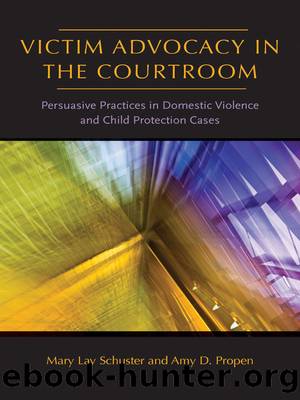Victim Advocacy in the Courtroom by Schuster Mary Lay;Propen Amy D.;

Author:Schuster, Mary Lay;Propen, Amy D.;
Language: eng
Format: epub
Publisher: Northeastern University Press
âTheir Homes Are Not Going to Look Exactly Like Mineâ: Ethnic and Socioeconomic Challenges
Building trust and credibility in the second arena in which GALs must do so, the family, can be additionally difficult because GALs so seldom share the ethnicity and socioeconomic background of the children and families with whom they work.15 As one judge speculated about differences in socioeconomic status, there are âsome guardians that still look at the families through their eyes, and those families will never be college-educated, upper-middle-class families, so your expectations that every child is going to get their own bedroom with their own full-sized bed and their own TV and DVD [player], I mean that's just not going to happenâ (JJJ8). Another judge noted similar ethnic tensions, âI often think it's very unfortunate when we have an African American family, and everybody around that family, the social worker, the judge, the guardian, the attorneys, everybody is white and predominantly female. And some of the men in these cases just get beside themselves, and I can't blame them because they feel this conspiracy of these white ladies trying to tell them what to doâ (JJJ3). And so, GALs who share ethnic identity or socioeconomic background are often deemed more trustworthy in the eyes of families, such as one GAL who self-identified as Spanish and was fluent in the language: âBecause of just my own background, I am sometimes ⦠given more trust, from a cultural understanding ⦠so I do get from the parents a lot of phone calls, âCan you please help us? No one understands. And can you please call, make this phone call for me ⦠or this was a concern I have, can you help me?ââ (GAL1V). Ethnic and socioeconomic differences, then, can create an initial gap or disconnect between families and GALs.16
GALs recognize this disconnect as a personal challenge in their trust-building activities: âI understand that their homes are not going to look exactly like [mine] ⦠it really doesn't have to do so much with ethnicity, as it has more to do with povertyâ (GAL4V). To address these challenges, some GALs develop working perspectives to accept a variety of basic differences: âI just think you have to be very calm about it, and I think you have to have a fairly calm demeanor, and listening skills play a huge role. I also think you have to be astute enough to understand that most of these parents, because most don't come from middle-class backgrounds with middle-class values, are used to surviving in situations that I am not used to on a daily basisâ (GAL8V). Certainly, the common concern with the best interests of the child constitutes an essential trust-building strategy: These families âare used to having people of the Caucasian race always making decisions for the welfare of their children, you have to let them know that you are sincerely interested in the well-being of the child, and ⦠you are not bringing any personal biases into this; it's really all about the child,â noted one GAL (GAL8V).
Download
This site does not store any files on its server. We only index and link to content provided by other sites. Please contact the content providers to delete copyright contents if any and email us, we'll remove relevant links or contents immediately.
Cecilia; Or, Memoirs of an Heiress — Volume 1 by Fanny Burney(32059)
Cecilia; Or, Memoirs of an Heiress — Volume 3 by Fanny Burney(31455)
Cecilia; Or, Memoirs of an Heiress — Volume 2 by Fanny Burney(31406)
The Lost Art of Listening by Michael P. Nichols(7159)
We Need to Talk by Celeste Headlee(5412)
Asking the Right Questions: A Guide to Critical Thinking by M. Neil Browne & Stuart M. Keeley(5355)
On Writing A Memoir of the Craft by Stephen King(4662)
Dialogue by Robert McKee(4160)
Pre-Suasion: A Revolutionary Way to Influence and Persuade by Robert Cialdini(3975)
I Have Something to Say: Mastering the Art of Public Speaking in an Age of Disconnection by John Bowe(3775)
Elements of Style 2017 by Richard De A'Morelli(3235)
The Book of Human Emotions by Tiffany Watt Smith(3138)
Fluent Forever: How to Learn Any Language Fast and Never Forget It by Gabriel Wyner(2915)
Name Book, The: Over 10,000 Names--Their Meanings, Origins, and Spiritual Significance by Astoria Dorothy(2836)
Good Humor, Bad Taste: A Sociology of the Joke by Kuipers Giselinde(2825)
Why I Write by George Orwell(2773)
The Grammaring Guide to English Grammar with Exercises by Péter Simon(2646)
The Art Of Deception by Kevin Mitnick(2622)
Don't Sleep, There Are Snakes by Daniel L. Everett(2499)
